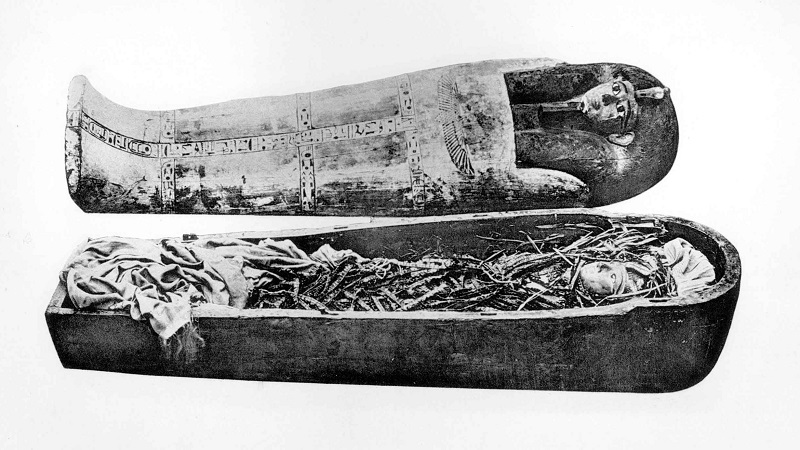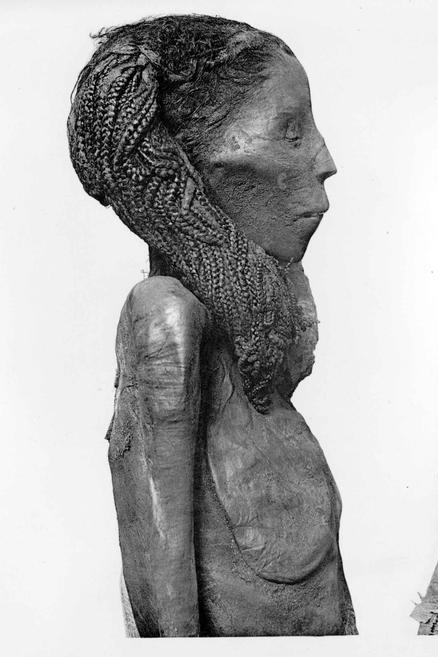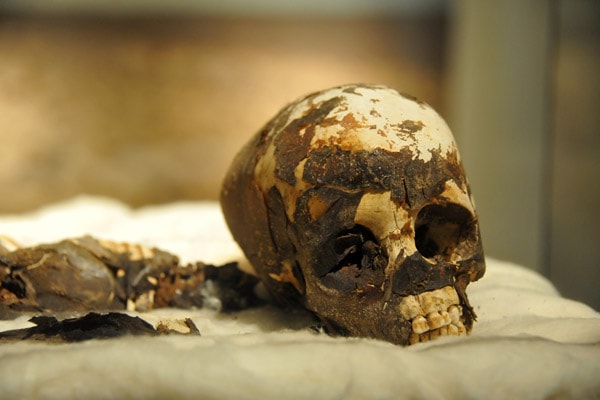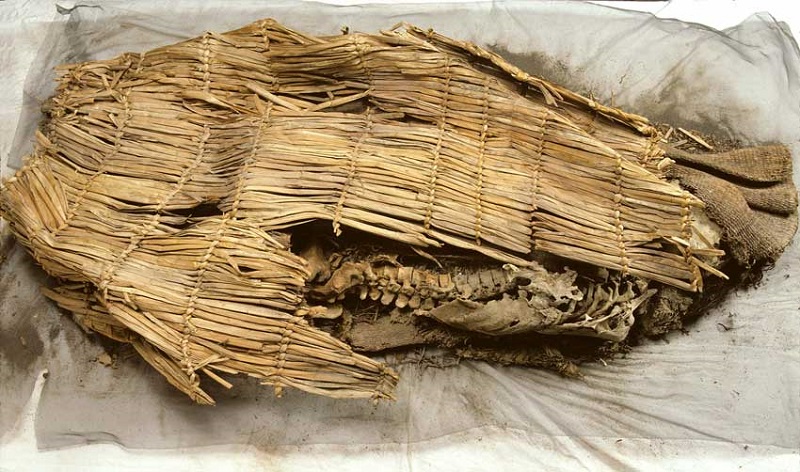Mummies are a staple of modern popular culture and are often featured in fictional works of horror. While there has never been any stories of real mummies reanimating, examination of their bodies does provide significant insight into the past.
By studying these mummies, we know what they ate, how they spent the last few days of their life, their medical history, and even their cause of death.
Most of the oldest mummies ever discovered were naturally preserved by such factors as arid dessert heat, mud, or layers of thick ice.
The oldest intentionally mummified people were found in South America and date back to about 5000 BCE, thousands of years before Egyptians started preserving their dead.
10. Ramesses II
Year of Death: 1213 BCE
Location: Valley of the Kings, Thebes, Egypt
Sex: Male
Year Discovered: 1881

Ramesses II, also known as Ramesses the Great, is often considered to be the greatest, most powerful, and most celebrated Pharaoh of the Ancient Egyptian Empire. He was the third Pharaoh of Egypt’s 19th Dynasty and ruled from 1279 – 1213 BCE.
Ramesses II was originally buried in a tomb in the Valley of the Kings, but was later transferred (because of looting) by priests to the tomb of Queen Inhapy. His body was moved again three days later to the tomb of high priest Pinudjem II — this story is inscribed on the linen covering his body.
During examinations of Ramessess II’s body, researchers discovered that he was originally a red head and that he had arthritis, which caused him to walk with a hunched back toward the end of his life.
9. King Tutankhamun
Year of Death: 1323 BCE
Location: Valley of the Kings, Thebes, Egypt
Sex: Male
Year Discovered: 1922

The discovery of King Tutankhamun‘s (commonly called King Tut) tomb is one of the most famous archaeological finds of the modern era. His tomb is one of the most intact ever found and it has produced more than 5,398 artifacts.
Since Tutankhamun’s tomb and body were well-preserved, researchers have been able to learn much about royal burials, mummification, and the tombs of Ancient Egypt’s 18th Dynasty.
Because not much was initially known about Tutankhamun’s death, there have been several conspiracy theories proposed that have infiltrated popular culture through movies, TV, and fictional books.
However, researchers believe that Tutankhamun’s death was unexpected and accidental, which explains why no records exist about his death and why his burial chamber was small for a Pharaoh.
8. Egtved Girl
Year of Death: c.1370 BCE
Location: Egtved, Denmark
Sex: Female
Year Discovered: 1921

The Egtved Girl is a well-known mummy from Denmark, which was buried in a well-preserved coffin that was uncovered in 1921. Although the tree-trunk coffin was well-preserved, the girl’s bones did not survive and only her clothing, hair, nails, and some teeth were in good condition. Also inside of her coffin were the cremated remains of a child that was about 5 or 6 years old.
Historians believe that the young lady was a priestess of a Scandinavian sun cult because of the spiral symbols on her belt.
More recent research has revealed that the girl was not originally from Denmark, but was from the Black Forest in Germany. It is believed that she may have married a chieftain in Denmark to form a strategic alliance.
7. Amenhotep I
Year of Death: 1506 BCE
Location: Deir el-Bahari, Egypt
Sex: Male
Year Discovered: Unknown

The mummy of Amenhotep I is unique and features one of the most exquisite and well-preserved face masks of any royal Egyptian mummy. Since the face mask is so delicate and beautiful, Amenhotep I is the only royal mummy who has not been unwrapped and studied by modern Egyptologists.
Amenhotep I was the second Pharaoh of Egypt’s 18th Dynasty.
He ruled from about 1526 BCE until his death in 1506 BCE. Sometime during the 20th (1189 BCE–1077 BCE) or 21st (1069 BCE to 945 BCE) Dynasty, Amenhotep I’s mummy was moved from its original resting place (which is unknown) to the Deir el-Bahri Cache and hidden with other royal mummies from Egypt’s New Kingdom time period.
6. Lady Rai
Year of Death: c.1530 BCE
Location: Thebes, Egypt
Sex: Female
Year Discovered: 1881

Lady Rai is one of the oldest known mummies uncovered in Egypt. She was discovered in 1881 and researchers estimate that she was about 30 – 40 years old when she died around 1530 BCE. From the writings left behind about Lady Rai, we know that she was the nursemaid to Queen Ahmose-Nefertari, who was the first Queen of the 18th Dynasty of Ancient Egypt.
The mummified body of Ahmose Inhapy, the aunt of Ahmose-Nefertari was found in Lady Rai’s outer coffin.
In 2009, researchers conducted a CAT scan of Lady Rai’s body and discovered that she had atherosclerosis. She is the oldest known mummy with the disease and several other Egyptian mummies also show signs of atherosclerosis.
5. Ötzi the Iceman
Year of Death: c.3300 BCE
Location: Ötztal Alps, near Hauslabjoch on the border between Austria and Italy
Sex: Male
Year Discovered: 1991


Ötzi the Iceman is one of the most famous mummies in the world. His accidental discovery in 1991 by two German tourists on a hike immediately drew worldwide media coverage. Since he was recovered from the Ötztal Alps, which he’s named after, he has been extensively studied. Due to the location of his death, Ötzi’s body was well-preserved by the ice.
Through different tests, we now know several things about Ötzi: he has living relatives who share a common ancestor that lived 10,000 – 12,000 years ago; he had over 50 tattoos across his body (some of the oldest tattoos ever discovered); he had anatomical abnormalities as well as several health problems; and his diet consisted of pollen and goats.
In 2012, scientists were able to extract red blood cells from Ötzi’s body.
4. Gebelein Man (“Ginger”)
Year of Death: c.3400 BCE
Location: Gebelein (now called Naga el-Gherira), Egypt
Sex: Male
Year Discovered: 1896

The Gebelein Man is the most well-known of the six naturally mummified bodies discovered in graves near Gebelein (now called Naga el-Gherira), Egypt. The Gebelein Man was the first uncovered at the site in 1896 and since 1901, the body has been displayed at the British Museum.
The mummy was nicknamed Ginger because of its visibly red hair.
In 2012, new research revealed that the Gebelein Man was probably murdered. Researchers have always noted the wound on the surface of the mummy’s skin, but did not discover how damaged his body was until they conducted a digital autopsy. They discovered that his shoulder blade as well as the rib under that shoulder blade were damaged, which suggests he died a violent death.
3. Tashwinat Mummy
Year of Death: c.3500 – 3300 BCE
Location: Uan Muhuggiag archaeological site in Libya
Sex: Male
Year Discovered: 1958

The Tashwinat Mummy found at the Uan Muhuggiag archaeological site in Libya is between 5,400 – 5,600 years old. The age of the mummy is significant because it predates any of the mummies found in neighboring Egypt. It was discovered by Professor Fabrizio Mori in 1958.
The mummy is a small child, about 3 years old, that was found in the fetal position. The body was embalmed, carefully wrapped with leaves, and covered by an antelope skin; its entrails were replaced with wild herbs to help with its preservation.
The Tashiwnat Mummy is currently the oldest known mummy from Africa. Since its discovery, researchers now believe that mummification in Africa did not start in Egypt, but probably elsewhere in the continent by an unknown civilization.
2. Chinchorro Mummies
Year of Death: 7020 BCE (oldest one named Acha Man) – 3000 BCE
Location: Northern Chile and southern Peru.
Sex: Males and Females
Year Discovered: 1917

The Chinchorro Mummies are considered to be some of the oldest mummies in the world. Since they were first discovered in 1917, over 282 mummies have been uncovered at burial sites along the narrow coastal strip from Ilo in southern Peru to Antofagasta in northern Chile.
About 29 percent of the mummies were naturally preserved, including the oldest mummy in the group, the Acha Man. Around 5000 BCE, the Chinchorro people began purposely mummifying their dead, about 2,000 years before the Egyptians started the practice.
The Chinchorro continued to preserve their dead until about 3000 BCE and developed three distinct styles of mummification — black, red, and mud-coated.
1. Spirit Cave Mummy
Year of Death: 9,400 years ago
Location: Spirit Cave, Fallon, Nevada
Sex: Male
Year Discovered: 1940

The Spirit Cave Mummy is the oldest known mummy in the world and is over 9,400 years old. It was first discovered in 1940 by Sydney and Georgia Wheeler, a husband and wife archaeological team. The Spirit Cave Mummy was naturally preserved by the heat and aridity of the cave it was found in.
In 1997, the Paiute-Shoshone Tribe of Nevada’s Fallon Reservation enacted The Native American Grave Protection and Repatriation Act (NAGPRA) to claim the Spirit Cave Mummy’s remains. For nearly two decades the Paiute-Shoshone Tribe fought a legal battle against the U.S. government, who did not want to return the mummy.
In 2016 the mummy was finally returned to the Paiute-Shoshone Tribe, after its DNA was sequenced to determine that he was related to contemporary members of the tribe.
OTHER POSTS YOU MAY BE INTERESTED IN











